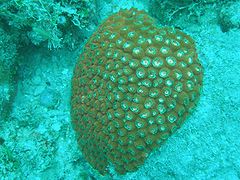User:Kit-kat94/sandbox/Great star coral
| Great star coral | |
|---|---|

| |
| Scientific classification | |
| Kingdom: | |
| Phylum: | |
| Class: | |
| Order: | |
| Family: | |
| Genus: | |
| Species: | M. cavernosa
|
| Binomial name | |
| Montastraea cavernosa Linnaeus, 1767
| |
The Great star coral (Montastraea cavernosa) is a colonial stony coral found in the Caribbean seas. It forms into massive boulders and sometimes develops into plates. Its Polyps are the size of a person's thumb and fully extend at night. Each animal is in one ring. sort of like a doughnut that's been cut in half.Each individual animal, or a polyp,lives in the center of the ring.By day, they hide down in holes in their skeletons.[1]The Great star coral colonies form massive boulders and domes over 5 feet (1.5 m) in diameter in waters of shallow and moderate depths. But in deeper waters, this coral has been observed growing as a plate formation. It is found throughout most reef environments, and is the predominant coral at depths of 40-100 feet (12.2-30.5 m).Corals are the building blocks of the coral reefs. All other coral-reef animals depend on them. They depend on the corals for their energy,food,shelter and protection. Corals remove calcium-based minerals from the ocean water and use these minerals to build a foundation that is very much like a skeleton.
The animals live on the outer surface of this skeleton. The corals can remove enough minerals so that the skeleton continues to grow each year. Corals like these Great Star Corals can build about 1/4 inch of skeleton each year.one of the things that actually threatens the Great Star Coral is Big waves when the corals are in shallow water, beacause the waves can cause damage both from its force, and by the sand they stir up that can settle onto the coral polyps. This coral occasionally has a fluorescent red and orange color during daytime, and at night it tends to have a blue/green color.It has recently been suggested that this color is due to phycoerythrin, a cyanobacterial protein. It appears that, in addition to symbiotic zooxanthella, this coral harbors endocellular symbiotic cyanobacteria, possibly to help it fix nitrogen. It usually lives in the Colombia Reef (Cozumel, Quintana Roo, Cozumel) and Typically found in water with a depth of 0 to -5,907 meters (0 to -19,380 feet).They tend to live in all reef environments, especially in the lower slopes, and comes from the family "Faviidae".
The little things that are on the outside are the tiny animals called Great Star Corals. Each animal is one orange tube, about as big around as a nickel (about 1/2 inch) and about as tall as they are wide. Each animal reaches out into the water with a ring of short, white tentacles, hoping to catch food as it floats or swims by. In the middle of some of the rings of tentacles you can see a slit that is the animal's mouth. The tentacles are lined with tiny white dots that are stinging cells called nematocysts. As we've learned in other Reef News web pages, each animal is called a polyp (say, "PAH-lip"). Each polyp will reach out into the water and seize its prey with its tentacles. The stinging nematocysts will kill or paralyze the prey, and then the polyp will drag its prey into its mouth.
References
[edit]- ^ "Common Corals of Florida". Retrieved 2008-05-29.
- Science article
- Oswold et al. 2007
- Younger, Mark. "common corals of Florida." ichthyology. 1 florda museum of natural history. 27 Jan. 2009 <http://www.flmnh.ufl.edu/FISH/southflorida/pisces.html>.
- Brac, Brac. "Star Corals." reefnews. 1 Day at Greenhouse Reef. 27 Jan. 2009 <http://www.reefnews.com/reefnews/photos/corals/daystars.html>.
